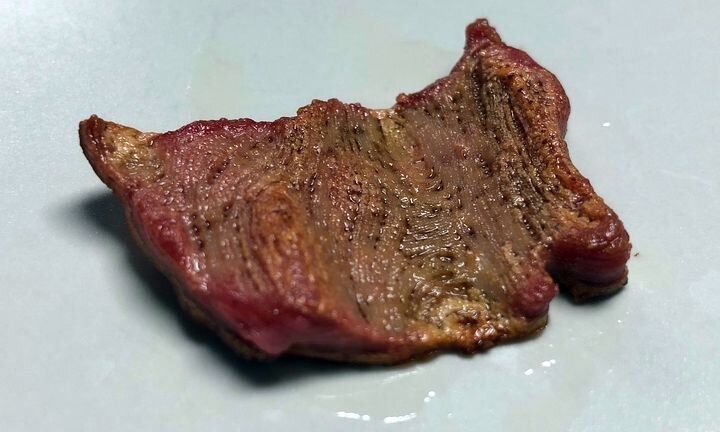![A not-too-bad-looking 3D printed steak [Source: The Guardian / Novameat]](https://fabbaloo.com/wp-content/uploads/2020/05/3dp-steak-fibers_img_5eb08bec89610.jpg)
I’m reading a story in the Guardian about a 3D printed steak and had some thoughts about 3D printed food.
3D printed food is an aspirational goal seen by many outside the 3D printing community. I cannot tell you how many times I am asked about 3D printed food by those new to the technology. There’s something unusual about food that makes the connection with 3D printing resonate with many people.
Why Interest In 3D Printed Food?
Perhaps it is that food preparation and cooking are near-universal skills, and that for many people it is their only experience with “making”. Thus they could relate to 3D printing in terms of food.
But that connection is not complemented by actual and practical methods of 3D printing food. There have been countless experiments, but in virtually all cases there have been significant constraints on food types, number of ingredients, print time and more. The 3D printed food vision extolled by dreaming chefs is no where near reality.
One of the many challenges to 3D printed food is texture. You might happen to have the right ingredients in proximity to each other in a food 3D print, but if the texture of the food is not “right” in your mouth, it’s a failure.
In the Guardian’s story, they tell the tale of Novameat, one of many ventures seeking to develop 3D printed food that could shift resources away from conventional animal farming by making better use of vegetable sources. It’s called “Plant-Based Meat”.
The Guardian says:
“The “most realistic” plant-based steak to date has been revealed, mimicking the texture and appearance of a real cut of meat.
The fake steak’s ingredients include pea, seaweed and beetroot juice, which are extruded into fine fibres to recreate muscle tissue. Its producer, the Spanish company Novameat, says the steak will be available in some restaurants in Spain and Italy this year before scaling up in 2021.”
Novameat launched a 3D printed steak two years ago, but the current version has significantly more texture. How is this achieved? It seems Novameat has devised an “micro-extrusion” system with nozzles 0.1 to 0.5mm in diameter.
I imagine that by applying multiple such extruders in parallel one could quite rapidly 3D print the steak, similar to how inkjet-style 3D printers can be scaled up both in build volume and print speed.
3D Printed Steak Cost
The Guardian says that a 50g steak produced using Novameat’s process cost only US$1.50, which is approximately the same cost as normal steak meat in the UK, but this is without production economies of scale. The eventual price could be much lower.
Novameat intends on licensing the extrusion technology to other parties once they’ve perfected the mechanism. This will allow other companies to produce 3D printed plant-based meats with functional textures using their own flavour designs.
A 3D Printed Food Universe
It’s possible this could lead to a mass availability of alternative meats based on plant material, or even entirely new types of food not previously imagined.
Fabbaloo readers are no doubt familiar with the world of conventional 3D printing, where the goal is to produce a durable and mechanically functional final object. That’s a very wide space involving many types of materials, machines and processes. But now it seems there may be yet another entire universe of materials, machines and processes evolving before us, and this time it’s all about food.
Via The Guardian and Novameat

